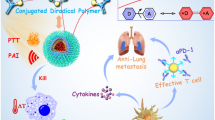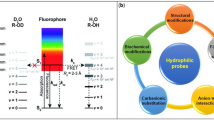Abstract
Spectroscopic studies of aqueous solutions of haematoporphyrin-type sensitisers reveal that photobleaching during eposure to light is followed by the formation of stable red-absorbing photoproducts. Experiments in model systems (sensitisers bound to human serum albumin or in a suspension of resealed erythrocyte ‘ghosts’) and in tumour tissue show that similar photomodification takes place in all investigated environments. Loss of total absorption and emission intensities is accompanied by an increase of absorption in the red spectral region (630–650 nm) which is used for the treatment of tumours because of the deeper penetration of light into tissues. This should be taken into account when the duration of illumination is chosen to reach an appropriate photodynamic dose using Hp-type sensitisers in the photodynamic treatment of tumours.
Similar content being viewed by others
Author information
Authors and Affiliations
Additional information
Received for publication 4 November 1996; accepted in revised form 17 March 1998
Rights and permissions
About this article
Cite this article
Rotomskis, R., Bagdonas, S., Streckyte, G. et al. Phototransformation of Sensitisers: 3. Implications for Clinical Dosimetry. Lasers Med Sci 13, 271–278 (1998). https://doi.org/10.1007/s101030050007
Published:
Issue Date:
DOI: https://doi.org/10.1007/s101030050007




